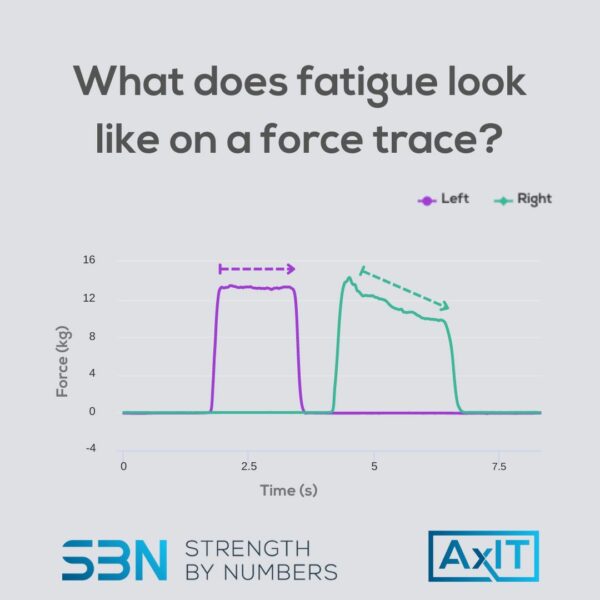As everyday health and fitness professionals, we are constantly searching for better ways to unlock the full potential of our clients. Now with the accessibility of more digital assessment tools such as dynamometers and force plates we are getting more information that ever about the physical profile of the people we work with.
Whilst smart handheld dynamometers and portable force plates like AxIT will do most of the heavy lifting in terms of generating baseline performance metrics to track over time, identifying imbalances and comparing to normative data, one often overlooked yet invaluable aspect is the force trace shape generated by these technologies.
In this article, we delve into 4 force trace shapes, exploring how it can offer more information to health and fitness professionals in guiding their clients toward optimal performance and well-being.

The peak force on a force trace is represented by how high it gets during an isometric strength test is one of the most used metrics as it is considered a good reflection of maximum strength for several reasons:
- Static contraction: In an isometric strength test, the muscle contracts against an immovable resistance, and the joint angle remains constant throughout the test. As a result, the peak force attained during the isometric test represents the maximum force the individual can generate at that specific joint angle and muscle length.
- Avoidance of stretch-shortening cycle: Isometric contractions eliminate the stretch-shortening cycle, which can influence force production during dynamic movements. During dynamic exercises (e.g., concentric and eccentric contractions in a movement like a squat or bench press), the stretch-shortening cycle utilizes stored elastic energy in the muscles and tendons, affecting the force output. In an isometric strength test, this factor is all but eliminated, providing a more direct measure of pure maximum strength.
- Reliability and consistency: Isometric strength tests are generally considered to be highly reliable and consistent when performed correctly and under standardized conditions. This makes the peak force measurement a reliable indicator of an individual’s maximum strength capacity at that specific joint angle.
- Easy to measure: Isometric strength tests are relatively straightforward to perform and require minimal equipment. The peak force measurement can be obtained using force plates or hand-held dynamometers, making it accessible in various settings.
It’s important to recognize that isometric strength tests assess strength only at specific joint angles and do not provide a comprehensive assessment of an individual’s overall strength capabilities across all ranges. Different joint angles may result in varying peak force values, highlighting the importance of considering a broader range of strength assessments for a more comprehensive understanding of an individual’s strength profile.

Rate of Force Development (RFD) is a crucial measure of explosive strength and reflects how quickly an individual can generate force and is typically represented by the “steepness” of the force trace curve.
RFD is vital for activities that require quick and powerful actions, such as jumping, sprinting, throwing, and various athletic movements but has also been shown to be one of the first muscle qualities lost due to age or may lag in the rehab process.
Here’s why RFD is a useful measure of explosive strength:
- Reflects neuromuscular efficiency: RFD is strongly influenced by the coordination between the nervous system and muscles. A high RFD indicates efficient neural activation and synchronization of motor units, allowing for rapid force production. This neuromuscular efficiency is critical for explosive movements, as it allows the muscles to generate force rapidly and generate high power output.
- Differentiates explosive strength: While peak force measures the maximum force output achieved during a movement or contraction, RFD assesses how quickly that force is reached. Two individuals might have the same peak force, but the one with a higher RFD will reach that peak force faster, indicating a greater ability for explosive strength.
- Sports performance: In many sports, such as sprinting, jumping, weightlifting, and throwing, success often depends on the ability to generate high forces quickly. Athletes with higher RFD can accelerate faster, jump higher, and throw with more power, giving them a competitive edge.
- Injury prevention: Explosive movements typically involve high forces in a short period. Individuals with a low RFD may be at a higher risk of injury during activities that demand quick and forceful actions. Training to improve RFD can enhance muscle responsiveness and potentially reduce the risk of injury.
On a force trace during strength testing, peak force could be the same or very similar between individuals or within the same individual during different attempts. However, the rate of force development can still differ significantly due to muscle fiber composition, neural factors, lack of confidence post injury or even training fatigue.

Muscle fatigue during an isometric strength test is typically evident on a force trace as a decline in force production over time. In the initial phase of the isometric contraction, the force trace usually shows a sharp rise, representing the peak force generated by the muscles during the voluntary effort. However, as the contraction continues, you may notice the force trace gradually declining when ideally it should be sustained for the duration of the contraction. This can be an important factor as two force traces with equal peak force and rate of force development metrics may have very different shaped curves of fatigue.
Muscle fatigue during an isometric strength test can manifest in different ways on the force trace:
- Gradual decline: The force trace may show a gradual decline in force output over time. As the muscles become fatigued, they are less able to sustain the same level of force production. This may be reflected in one force curve or maybe a reduction in peak force maximum across multiple force curves with multiple repetitions.
- Fluctuations: Muscle fatigue may lead to force fluctuations on the trace, with force output oscillating up and down around a lower average force level. This pattern can be a result of the muscles struggling to maintain a steady force due to fatigue.
- Early peak and rapid decline: In some cases, the force trace may show an early peak in force, followed by a rapid decline in force production. This pattern suggests that the muscles quickly reach their maximum capacity but fatigue sets in rapidly afterward.
Understanding how the force output changes over time can provide valuable information about an individual’s muscle endurance and fatigue resistance. The ability to sustain force production over time is critical for various functional activities and sports, and identifying signs of fatigue can help tailor training and rehabilitation programs to address specific weaknesses and improve overall muscle performance.

The presence of irregularities or fluctuations in a force trace during force analysis may suggest an issue with motor control. Motor control is critical in coordinating and executing movements smoothly and efficiently such as dynamic movements like lunges, squats, and jumping. It involves the nervous system’s ability to direct and regulate muscle contraction, ensuring precise and coordinated movements. When irregularities appear in the force trace, the motor control process may not be functioning optimally. Whilst some movements will have very classic force signatures the key is usually a smoothness of force application across the force trace when analysing motor control.
- Coordination of Muscle Activation: A well-coordinated movement like a lunge requires precise timing and sequencing of muscle activation. Motor control ensures that the appropriate muscles fire in the correct sequence to execute the movement smoothly. Often an efficient and effective movement will present as a smooth force curve as force is absorbed and transferred. Irregularities in the force trace, such as abrupt changes in force output, or a double peak may indicate a lack of coordination in muscle activation, leading to jerky or unstable movements.
- Balance and Stability: Motor control plays a crucial role in maintaining stability during movements. When there are irregularities in the force trace, it may suggest that the client is struggling to stabilize the joints or maintain balance during the task, indicating potential deficits in motor control.
- Compensatory Movements: Clients with motor control issues might adopt compensation strategies to perform movements. These strategies can lead to force fluctuations as different muscles or movement patterns are used to compensate for deficits in motor control.
By analyzing force traces and identifying irregularities or fluctuations, health professionals can gain valuable insights into their patients’ motor control capabilities. Understanding these issues can help in developing targeted rehabilitation strategies to address motor control deficits, improve movement patterns, and enhance overall motor performance.
Want to learn more?
Are you interested in upgrading your assessment? Speak with our team today about how AxIT can help you set baselines, track progression of the people you work with and save valuable admin time. Click here to book an online demonstration.

